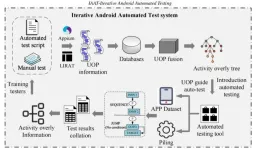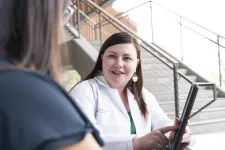(Press-News.org) A recent study published in Progress in Neurobiology and led by researchers at the University of Arizona College of Medicine – Tucson has developed an improved method to study Parkinson’s disease in the lab. Along the way, researchers also uncovered clues that may help scientists figure out how to detect Parkinson’s earlier and point the way toward better treatments.
Around a million Americans are living with Parkinson’s disease, a neurological disorder that causes difficulty in movement, balance and cognition. Symptoms worsen until tasks like walking, talking and swallowing present enormous challenges. While there is no cure, there are treatments that control symptoms — but their effectiveness wanes over time and they are associated with unwanted side effects.
“It’s a slow-developing disorder. We only diagnose the disease at a late stage, when 60-70% of dopamine neurons are dysfunctional or have died off,” said Lalitha Madhavan, MD, PhD, associate professor of neurology at the College of Medicine – Tucson, part of UArizona Health Sciences. “We have treatments, but at that point you’re trying to throw a small glass of water on a raging fire. Being able to diagnose the condition at the earliest stages would be a big step.”
Madhavan’s team used cells from Parkinson’s patients to create a human-derived laboratory model to study the disease. Using induced pluripotent stem cell technology — a powerful technique that transforms adult cells into embryo-like cells that can then mature into any cell type — the lab reprogrammed adult skin cells called fibroblasts into brain cells.
Using the reprogrammed neurons, Madhavan Lab researchers discovered several changes in the cells from Parkinson’s subjects that differentiated them from cells of healthy individuals. Madhavan hopes this finding can form the basis for better cell-culture systems for studying Parkinson’s disease in the lab, potentially leading to improved diagnostics and treatments.
The experiments also showed that skin cells may act as a window into the brain. Skin cells don’t cause neurological symptoms, but some of the same changes that damage brain cells might also affect skin cells, producing similar molecular “signatures.”
“We wanted to make neurons from skin biopsies using this fantastic technology; however, we noted along the way that the fibroblasts themselves seemed to have signatures that differentiated individuals with Parkinson’s. We started to dig deeper into that,” Madhavan said. “It’s exciting that we’ve shown that connection, and that it tells us skin cells could perhaps be used to diagnose the disease early.”
The team hopes that, in the future, doctors will be able to catch Parkinson’s disease earlier by examining skin cells for signs that the disease is brewing.
“This could be a system in which we could very carefully diagnose people at early stages,” Madhavan said, adding that her team received a patent on a method for examining skin cells for molecular signs that correlate to Parkinson’s disease.
They are now investigating how skin cells change over time to learn more about how the disease progresses and how to identify it early. Tech Launch Arizona, the University of Arizona’s technology commercialization office, is helping protect the innovation and developing strategies to take it from the laboratory to the marketplace where it can impact the lives patients and their doctors.
Madhavan says that if we could catch Parkinson’s disease earlier, doctors could prescribe currently available treatments that can slow disease progression. Simultaneously, scientists could work to develop next-generation Parkinson’s drugs that target the disease in its early stages.
Because a patient’s skin cells are easy to access — especially compared to brain cells — Madhavan also hopes the system could be used for a precision-medicine approach, matching patients with optimized treatments based on a skin biopsy and lab test showing which drug might work best based on their unique genetic profile.
“We’ve been putting Parkinson’s into one big bucket when actually different people express it differently,” she said. “This system would allow us to carefully classify Parkinson’s and assess treatments more effectively based on such a classification.”
The lead authors on the study were Mandi Corenblum, MS, senior research specialist, and Aiden McRobbie-Johnson, physiological sciences graduate student. Co-authors include Kelsey Bernard and Timothy Maley, graduate students in neuroscience and physiological sciences; Emma Carruth, undergraduate student in physiology; Moulun Luo, PhD, associate research professor of medicine; Lawrence Mandarino, PhD, professor of medicine; Maria Sans-Fuentes, PhD, BIO5 Institute statistician; Dean Billheimer, PhD, professor in the UArizona Mel and Enid Zuckerman College of Public Health and director of statistical consulting at the BIO5 Institute; and Erika Eggers, PhD, professor of physiology and member of the BIO5 Institute.
The study was supported mainly by a Michael J Fox Foundation grant (MJFF 18366) and in part by grants from the National Eye Institute, a division of the National Institutes of Health, under award nos. R01EY026027 and NSF1552184.
END
A better way to study Parkinson’s disease in the lab could lead to earlier diagnosis
College of Medicine – Tucson researchers used stem cell technology to improve research models for Parkinson’s disease.
2023-11-16
ELSE PRESS RELEASES FROM THIS DATE:
Night-time radiative warming using the atmosphere
2023-11-16
Warming has played a crucial role in various industrial and agricultural processes throughout history. Night-time warming, however, presents a distinct challenge due to the absence of solar radiation. During the night, direct radiative heat loss to outer space through the atmospheric transparent window (8-14 μm) can cause temperature to drop below freezing, posing significant threats to agriculture (crops), transportation (outdoor cables), and more.
Traditionally, achieving night-time warming ...
A bi-directional iterative approach to Android automated testing
2023-11-16
With the benefits of reducing time-cost and human efforts, automated testing has been widely used for quality assurance of mobile applications (apps). However, in complex interactive activities, manual testing can achieve higher coverage. However, the effectiveness of manual testing is highly dependent on the vital User Operation Process (UOP) of experienced testers.
To solve the problems, a research team led by Zhenyu CHEN and Chunrong FANG published their new research on 15 Oct 2023 in Frontiers of Computer Science co-published ...
Oregon State researchers receive $2M to look for new ways to prevent organic potatoes from spoiling
2023-11-16
CORVALLIS, Ore. – Oregon State University researchers have been awarded $2 million from the U.S. Department of Agriculture to develop improved ways of preventing stored potatoes from sprouting, particularly in the organic sector.
This research is pivotal given the rapid rise of the organic market in U.S. agriculture, the scientists note.
“The organic potato industry cannot depend on traditional chemical anti-sprouting treatments since synthetic chemicals are banned in certified organic,” said Valtcho Jeliazkov of OSU’s College of Agricultural ...
Why it’s important to improve communication of unanticipated genomic findings to patients with late-stage cancer
2023-11-16
New research conducted by City of Hope and supported by the American Cancer Society focuses on developing scalable educational interventions to support informed patient decision making and consent, such as online tools and applications that include visual aids or interactive multimedia.
FINDINGS
Cancer genomics experts at City of Hope®, one of the largest cancer research and treatment organizations in the United States, conducted a qualitative study that underscored the importance of properly preparing patients for unanticipated, inheritable genetic findings prior to receipt of ...
New studies of brain activity explain benefits of electroconvulsive therapy
2023-11-16
Electroconvulsive therapy (ECT), formerly known as electroshock therapy, involves inducing a brief seizure in the brain using controlled doses of electricity. While ECT is highly effective for certain mental illnesses, particularly depression, the reasons for its efficacy have long puzzled the fields of psychiatry and neuroscience.
Now, researchers from University of California San Diego may have an answer. In two new studies published November 16, 2023 in Translational Psychiatry, they propose a new hypothesis that ECT alleviates depression symptoms by increasing aperiodic activity, a type of electrical activity in the brain that doesn’t follow a consistent pattern ...
McWilliams School of Biomedical Informatics researchers awarded $31M in grants for medical artificial intelligence innovation research
2023-11-16
McWilliams School of Biomedical Informatics at UTHealth Houston reached a funding landmark with 15 faculty members awarded 16 different grants totaling more than $31 million between August and October 2023. Each grant has a focus on medical artificial intelligence (AI) innovations and advancements in research or health care.
“This is an incredible achievement for McWilliams School of Biomedical Informatics; these grants play a key role in advancing informatics research while also expanding on the important role technology continues to play in medicine,” said Jiajie Zhang, PhD, dean and Glassell Family Foundation Distinguished Chair in ...
The BMJ investigates concerns over informed consent for pregnant women in Pfizer’s RSV vaccine trial
2023-11-16
A debate has broken out over whether Pfizer should have told pregnant women taking part in its maternal respiratory syncytial virus (RSV) vaccine trial that a trial of a similar GSK vaccine was stopped over a safety signal around preterm birth, an investigation by The BMJ can reveal.
Pfizer’s vaccine, called Abrysvo, was recently approved for use in the US and the European Union, but is not yet authorised in the UK.
Some experts have criticised Pfizer for not informing participants, while others believe notification would have been premature and caused unnecessary anxiety, reports freelance investigative journalist Hristio ...
No one-size-fits-all solution for the net-zero grid, Surrey research demonstrates
2023-11-16
As power generation from sources like solar and wind increases, along with the introduction of devices such as heat pumps and batteries, a new optimisation tool created at the University of Surrey will help the UK plan for a greener electricity network.
The researchers developed an algorithm to model how these smaller networks distributed electricity – factoring in how local grids could become unbalanced by adding too many heat pumps in a single area or generating more electricity than the grid could accept.
The Surrey team found that it was generally more efficient ...
Nuclear expansion failure shows simulations require change
2023-11-16
The widespread adoption of nuclear power was predicted by computer simulations more than four decades ago but the continued reliance on fossil fuels for energy shows these simulations need improvement, a new study has shown.
In order to assess the efficacy of energy policies implemented today, a team of researchers looked back at the influential 1980s model that predicted nuclear power would expand dramatically. Energy policies shapes how we produce and use energy, impacting jobs, costs, climate, and security. These policies are generated using simulations (also ...
7 countries, 1.3 million lives lost – the devastating impact of tobacco revealed
2023-11-16
Strict embargo: 00.01 hrs GMT
Thursday, 16th September, 2023
Every year 1.3 million lives are lost to cancers caused by smoking tobacco across the UK, US and BRICS nations (Brazil, Russia, India, China and South Africa), according to a new study, funded by Cancer Research UK.
Researchers found that together, the seven countries represented more than half of the global burden of cancer deaths every year. They concluded that smoking, as well as three other preventable risk factors – alcohol, overweight or obesity, and human papillomavirus (HPV) infections caused almost 2 million deaths combined.
The study, carried out ...
LAST 30 PRESS RELEASES:
A new way to map how cells choose their fate
Numbers in our sights affect how we perceive space
SIMJ announces global collaborative book project in commemoration of its 75th anniversary
Air pollution exposure and birth weight
Obstructive sleep apnea risk and mental health conditions among older adults
How talking slows eye movements behind the wheel
The Ceramic Society of Japan’s Oxoate Ceramics Research Association launches new international book project
Heart-brain connection: international study reveals the role of the vagus nerve in keeping the heart young
Researchers identify Rb1 as a predictive biomarker for a new therapeutic strategy in some breast cancers
Survey reveals ethical gaps slowing AI adoption in pediatric surgery
Stimulant ADHD medications work differently than thought
AI overestimates how smart people are, according to HSE economists
HSE researchers create genome-wide map of quadruplexes
Scientists boost cell "powerhouses" to burn more calories
Automatic label checking: The missing step in making reliable medical AI
Low daily alcohol intake linked to 50% heightened mouth cancer risk in India
American Meteorological Society announces Rick Spinrad as 2026 President-Elect
Biomass-based carbon capture spotlighted in newly released global climate webinar recording
Illuminating invisible nano pollutants: advanced bioimaging tracks the full journey of emerging nanoscale contaminants in living systems
How does age affect recovery from spinal cord injury?
Novel AI tool offers prognosis for patients with head and neck cancer
Fathers’ microplastic exposure tied to their children’s metabolic problems
Research validates laboratory model for studying high-grade serous ovarian cancer
SIR 2026 delivers transformative breakthroughs in minimally invasive medicine to improve patient care
Stem Cell Reports most downloaded papers of 2025 highlight the breadth and impact of stem cell research
Oxford-led study estimates NHS spends around 3% of its primary and secondary care budget on the health impacts of heat and cold in England
A researcher’s long quest leads to a smart composite breakthrough
Urban wild bees act as “microbial sensors” of city health.
New study finds where you live affects recovery after a hip fracture
Forecasting the impact of fully automated vehicle adoption on US road traffic injuries
[Press-News.org] A better way to study Parkinson’s disease in the lab could lead to earlier diagnosisCollege of Medicine – Tucson researchers used stem cell technology to improve research models for Parkinson’s disease.







